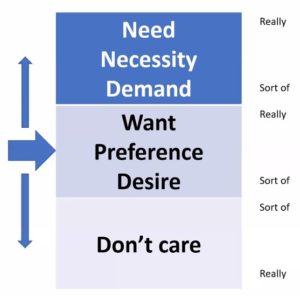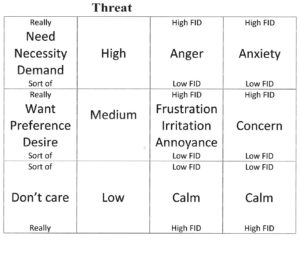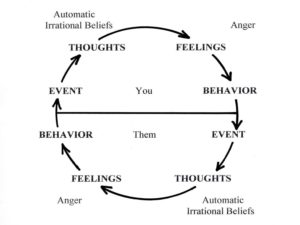Applying the concepts of Rational Emotive Behavioral Therapy (REBT) and Education to the goal of Peace
Step 1: Start by teaching and encouraging students to adopt the belief that all people have the right to want whatever they want. Inherent in that belief is that people will often want different things at the same time and there may be conflicts. However, taking the position that others should not or cannot want what they want would cause needless conflicts and only exacerbate any conflicts that already exist.
Step 2: Explain that the real underlying cause of needless emotional disturbance, unhelpful behavior and exacerbated conflicts at all levels of human interaction according to the late Dr. Albert Ellis is that people start to treat simple wants as needs (called PERCEIVED needs as opposed to real biological needs like air, water and food), start to treat simple preferences as necessities, and start to DEMAND what they simply desire. It helps to use a thermostat model to visually portray the three levels people have for looking at things.

Step 3: Explain the important role of emotion in everyday life. Emotion is essentially energy to move to help people deal with threats and get what they want and need. The greater the difference between a person’s expectations and reality the greater the perceived threat will be, and the more emotion they will generate. This is something human beings are hardwired to do. The real problem is that people too often manufacture threats where they don’t exist, and/or magnify ones that might out of proportion to reality. This causes them to generate more emotion or energy to move than is helpful or necessary. They do that by treating their simple wants as needs, by elevating their simple preferences to necessities, and by demanding what they simply desire. People often will even equate what they want to air, water and food in their minds. This maximizes the perceived threat if or when they don’t get what they want or lose it. This is one type of irrational thinking Dr. Ellis called DEMANDINGNESS. A simple definition of irrational is that thinking (or feeling, saying and doing something) a certain way makes people feel worse than is necessary or helpful, and causes them to say and do things that make life worse for themselves and sometimes others. Dr. Ellis would say there is a qualitative difference between emotions like frustration, irritation, annoyance and anger, between concern and anxiety, between regret and shame, between remorse and guilt, between sadness and depression. The reason is because they stem from different ways of looking at thing. For example, frustration, irritation and annoyance come from wanting, preferring and desiring something and not getting it, or losing it. Emotion can also arise simply from imagining not getting something or losing it. Anger comes from a person believing he/she needs something, it is a necessity and demanding it. With any emotion, the frequency, intensity and duration can vary depending on how much people want, prefer or desire something, or think they need it, it is a necessity and demand it. It can be visually portrayed in the following way.

Step 4: Explain the effect emotion or energy to move has on behavior. If people have little or no emotion they will not be motivated to take action. If they have frustration, irritation and annoyance, or concern, they will be motivated to act, but will still be free to respond in the best possible way. Responsibility (response-ability) means the ability to respond in the best possible way. Being responsible (response-able) means being able to respond rather than reacting or overreacting to what is happening. To respond in the best possible way, it helps to access and act on information, advice and experience a person has accumulated over time, and in accordance with any values or morals they have developed. It also helps to consider the potential consequences of any course of action before taking it. However, as the level of emotion rises, people become more likely to react and doing such things becomes more difficult and less likely. That would make sense if the threat was large and looming, perhaps even a matter of life or death. There is an old saying “He who hesitates is lost”. There may be truth in that if a threat is truly life threatening. However, people often make mistakes when they react or overreact. There is a saying “There’s two ways to make something you don’t like worse – do nothing and overreact to it”. People too often do the latter because they generate more emotion than is necessary or helpful. Thy do that because they elevate simple wants, preferences and desires to needs, necessities and demands. See the visual below.

Step 5: Explain that conflicts are inevitable because people can and often will want different things at the same time, i.e. teachers and students, parents and children. However, the key to preventing, de-escalating and ultimately resolving conflicts is for people to learn to keep their FEEL thermostats down, and to turn them down quickly should they go up. That will make them less likely to overreact to what they don’t like and allow them to be more response-able. The key to keeping their FEEL thermostat down, or being able to turn it down quickly, is to learn to keep their THINK thermostats down, or turn it down quickly should they go up.
Step 6: Teach and encourage students to have what Dr. Ellis called UOA or Unconditional Other Acceptance. It means choosing to see whatever others think, feel, say or do as part of being human, and understandable given what their life experiences have been. Understandable means that if any human being had similar life experiences, they would probably end up thinking, feeling, saying and doing much the same. Some might fare better, but others might fare worse. However, most would probably end up thinking, feeling, saying and doing much the same. One strategy for encouraging this is to ask students to imagine that on the day they were born, scientists took 100 other newborns and from that day forward, put all 100 through exactly the same life experiences. It can help to talk about bell curves where there are always some who do very well at something, some who do poorly at the same thing, and a whole bunch in between. Another simple strategy is to suggest that all people should come with a movie of their lives. Then pose the question, if others watched a movie of a person’s life, would they probably see the understandable reasons why that person thinks, feels, say or does what he/she does? A third strategy is to introduce the formula NATURE + NURTURE = PERSONALITY, where NATURE represents all those constants about human development, NURTURE represents a person’s life experiences, and PERSONALITY represents a pattern of thoughts, feelings and behaviors. It is like the formula a + b = c, where a is a constant and b is a variable. If a stays the same and you change b, c changes. Likewise, a person’s life experiences (NURTURE) make a big difference in what pattern of thoughts, feelings and behavior (PERSONALITY) results. Another strategy is to ask the following questions. “Will anyone ever be the first person in human history to think, feel, say or do something? Will anyone ever be the last? Will people always have a lot of company when it comes to what they think, feel, say or do? What does that suggest about what people think, feel, say or do?” The answer is that it is part of being human. It also can help to introduce the term FHB used by Dr. Ellis. It means Fallible Human Being. Fallible means that no one is perfect and everyone makes mistakes. Every human being at times will think, feel, say and do things that make their own and others lives worse instead of better. Finally, explain that having UOA does not mean people have to like, agree with or even tolerate what others think, feel, say or do. Looking at things this way simply helps temper peoples’ emotional response to what others think, feel, say or do that they don’t like or don’t agree with.
Step 7: Talk about the concept of LOCUS OF CONTROL. Explain that locus of control is the term for where people see their feelings as coming from, what they see as the cause of them. Explain that most people have an EXTERNAL locus of control. That means that they see how they feel as being caused by what others say or do, or what happens. Suggest that students listen to the way they and others talk about feelings and how they come about, i.e. “That really ticks me off”. Offer examples. Explain that it is perfectly understandable that most people have an external locus of control for a number of reasons. One is that everyone grows up usually surrounded by others who talk about their feelings and how they come about that way. Another is that feelings come so quickly after others say or do something, or something happens, that it is easy to conclude that the latter causes the former – that there can’t be any intervening variable. However, the problem with looking at life this way is that it puts people at the seeming mercy of others comments, actions and the events of their lives. That often lead to them feeling worse than is necessary or helpful, for longer than necessary. More importantly, it implies that others must start acting differently and better, or their life events must improve in some way for them to start feeling better. What if neither ever do change? Looking at life this way causes people to miss many opportunities to feel better.
Step 8: Teach and encourage students to develop an INTERNAL locus of control. Teach them a formula for how life always unfolds: EVENT + THOUGHTS = FEELINGS > BEHAVIOR. Anything that others say or do or that happens is just an EVENT in this formula. Human brains are always generating THOUGHTS about what is happening to make sense of what is, to recognize any potential threats. Explain that it is what people think about what happens or what others say and do that actually causes how people feel. THOUGHTS cause FEELINGS, not EVENTS. You can do multiple thought experiments to demonstrate this. Give them two different ways of looking at the same EVENT, and ask them which way would cause a person to feel better, and which way worse. There are two other statements that stem from this formula. One is “Attitude is always the father of behavior”. The other is “A person’s BEHAVIOR will tend to follow his/her FEELINGS toward his/her life EVENTS”. The second simply means that an angry person will tend to behave the way angry people typically do. It can help to teach students Dr. Albert Ellis’ ABC Theory of Emotions. It is summarized in the formula ACTIVATING EVENT + BELIEFS = CONSEQUENCES, where BELIEFS represents all those things someone might think about what happens, others, themselves and life because of the ACTIVATING EVENT, and CONSEQUENCES means what someone feels or does as a consequence of what they believe. It helps to point out that this formula is also like a + b = c, where a is a constant, and b is a variable. If a stays the same, and you change b, c changes. Likewise, if people change their BELIEFS about the events of their lives, others, themselves and life itself, their feelings will change, for the better or worse depending on what the beliefs are. Teach them new ways of talking about feelings, i.e. “No one upsets me, I upset myself”, “I’m responsible for how I feel, not others”.
Step 9: Teach and encourage students that it is important to know and always remind themselves what they do and don’t have control over. No one ever really can control what others think, feel, say and do. Many people think they can, and talk and act as if they do, but they do not, and doing so only encourages others to prove otherwise. Use the Circle of Conflict diagram. This visually portrays how conflict unfolds. One person says or does something. That’s an EVENT for another person. That other person generates THOUGHTS about the EVENT. Those THOUGHTS may cause some FEELING which drives them to engage in some type of BEHAVIOR. That BEHAVIOR becomes an EVENT for the other person who then goes through the same sequence. This is how conflicts arise and escalate, step by step. The important question to ask students is “Which half of the circle do people really have control over?” Another question is “Which half do most people spend much of their time, energy and effort trying to control?” Which is why conflicts so often escalate.

Step 10: Introduce the concept of “mistaken” goals to students. People often adopt “mistaken” goals that get them off course from getting what they want. Two common mistaken goals in conflict situations are POWER AND CONTROL and REVENGE. Too often the goal becomes about exerting power and control over others in an attempt to get what is wanted, or simple getting even for some real or perceived transgression.

Step 11: Teach students the three other types of irrational thinking identified by Dr. Ellis: AWFULIZING, CAN’T STAND IT-ITIS, LABELING AND DAMNING. There are many things in life that are unpleasant, inconvenient and uncomfortable. The mistake people make is to tell themselves that what has happened was AWFUL, or that what might would be – the worse possible thing that could happen. Suggest to students that everyone has the right to like or dislike whatever they want to. However, the problem is that people too often turn their THINK thermostat up a notch and tell themselves that they CAN’T STAND what is happening or couldn’t if it did. This needlessly inflames them, which is why Dr. Ellis added the suffix -ITIS. People can dislike what others think, feel, say or do. That’s their right as a human being. However, people often LABEL AND DAMN a person instead of just disliking his/her behavior. It’s condemning the DOER instead of the DEED. It’s like calling an apple “bad” simply because it has a bruise, even though the bulk of the apple is just fine. People can LABEL AND DAMN others or themselves. These three types of irrational thinking naturally stem from DEMANDINGNESS as portrayed in the following diagram.
Step 12: Teach students simple ways to challenge their own irrational thoughts. For example, by teaching and encouraging them to practice asking themselves and others simple questions like the following. “They NEED (HAVE) to, or you just WANT them to?”, “Is it AWFUL, or just unpleasant, inconvenient and uncomfortable?”, “You CAN’T STAND it, or just don’t like it?”, “They’re a jerk, or just did something you didn’t like?” The goal is not to get students to not care about things. It is simple to turn their THINK thermostats down a notch. That will turn their FEEL thermostats down and free them to be more response-able.
Step 13: Brainstorm with students a list of what Dr. Ellis called EFFECTIVE COPING STATEMENTS. These are things they could think instead of the automatic irrational thoughts that so often pop into peoples minds before, during and after conflicts. Have them create COPING CARDS using a 3×5” index card on which they least 5 statements that might help them keep their FEEL thermostat down, or turn it down quickly should it go up. Encourage them to practice and rehearse these statements.
Step 14: Teach students a paradigm developed by the late Dr. Paul Hauck. He said that whenever we don’t like something that is happening, we have four basic options. One is to PROBLEM SOLVE AND ASSERT. What people to often do is become AGGRESSIVE instead of ASSERTIVE. They do that because they generate more emotion than is necessary or helpful. They do that because of how they choose to think. A second is the TOLERATE WITH DISTURBANCE. This unfortunately is the one people too often do. A third is TOLEARTE WITHOUT DISTURBANCE. The only catch is that people get what they tolerate. If people tolerate what others say and do, what reason do other people have to consider changing. A final option is to LEAVE.
Step 15: Teach students the difference between YOU MESSAGES and I MESSAGE. YOU MESSAGES are what people too often use with others. They include orders, threats, namecalling, demands, and putdowns. They are also called solution messages because they try to take away another person’s right to think, feel, say or do whatever they want to. That only invites others to try to prove they are in control, even if it means doing something that self-defeating or even dangerous. YOU MESSAGES often involve pointing a finger at others. No one likes that. I MESSAGES simply give others information and leave it up to them as to what they want to do with that information. That information may be what people don’t like and don’t want, and perhaps how they feel. It helps to also include what people like or want instead. It also helps to depersonalize I MESSAGES with words like WE, OTHERS, SOMEONE or ANYONE. For example, “I don’t like when ANYONE says that” instead of “I don’t like when YOU say that”. If I messages don’t work, people can’t try the “broken record technique” and simply repeat them. Writing letters using only I MESSAGES is also a constructive way to approach someone about a conflict that otherwise escalates quickly when face to face. In the end, it’s important to remind students what they do and don’t have control over, and what their other three options are if asserting themselves does not work.
